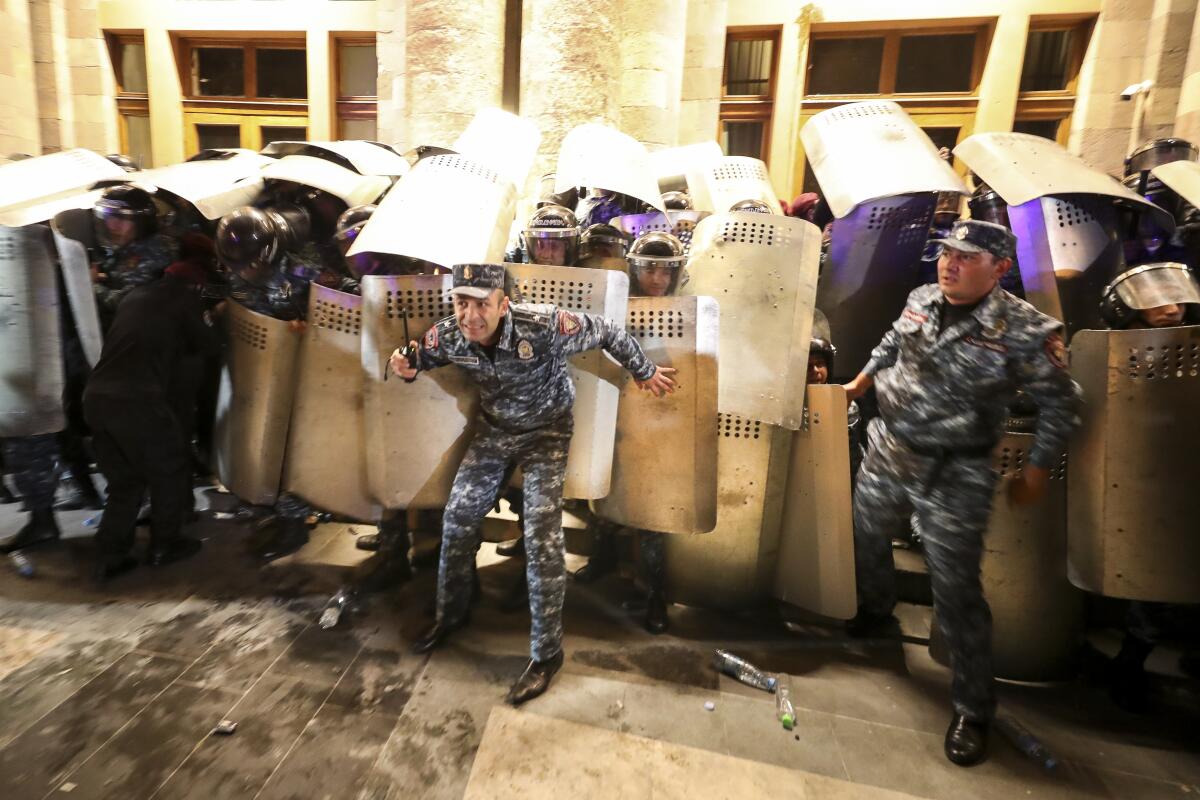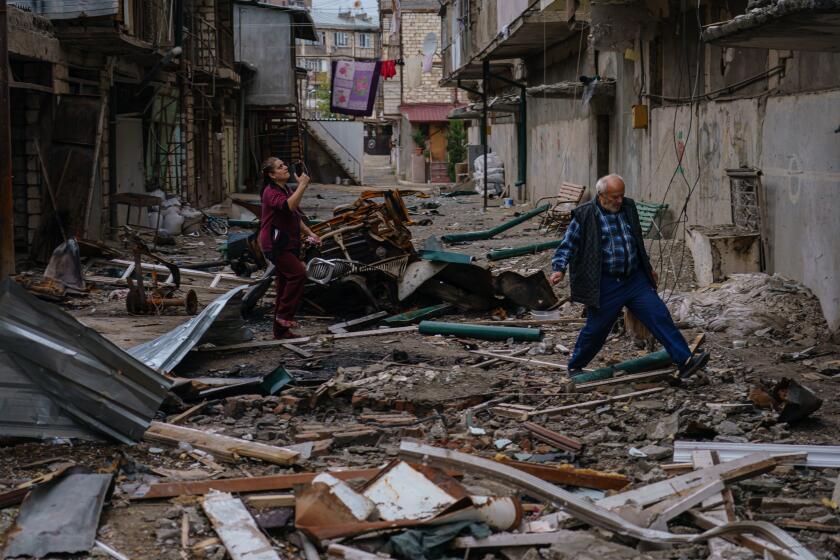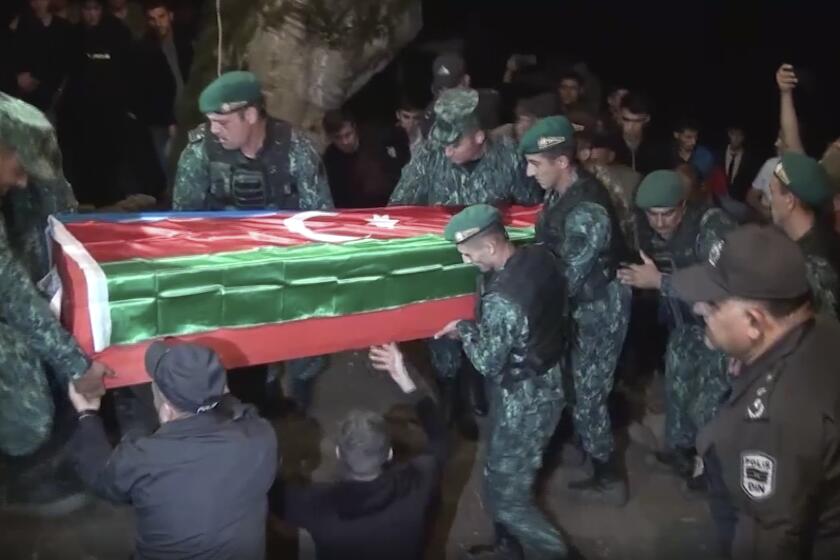Azerbaijan and Armenian forces reach cease-fire deal for Nagorno-Karabakh

- Share via
YEREVAN, Armenia — Azerbaijan and Armenian forces reached a cease-fire agreement Wednesday to end two days of fighting in the separatist Nagorno-Karabakh region, which has been a flashpoint for decades, officials on both sides said.
An hour after the truce was announced, Armenian Prime Minister Nikol Pashinyan said that the intensity of the hostilities in the region “has decreased drastically.” Azerbaijani authorities said they had halted the military operation, launched a day earlier, once separatist officials announced the laying down of arms.
It wasn’t immediately clear if some fighting continued, but both sides agreed to talks Thursday on the “re-integration” of the region into Azerbaijan. That, in addition to guarantees to lay down arms, was widely viewed as a victory for Azerbaijan.
On Tuesday, Azerbaijani forces used heavy artillery on Armenian positions in Nagorno-Karabakh, a mountainous a region that is part of Azerbaijan but came under the control of ethnic Armenian forces during a separatist war in the 1990s.
Scores of people were reportedly killed and wounded in the latest fighting. The hostilities also exacerbated an already grim humanitarian situation for residents who have suffered food shortages for months.
The escalation raised concerns that a full-scale war in the region could resume between Azerbaijan and Armenia, which have been locked in a struggle over the region since the collapse of the Soviet Union. The most recent heavy fighting there occurred over six weeks in 2020, when Azerbaijan retook parts of the region and areas around it that were lost in the earlier separatist war.
The hostilities raging in Nagorno-Karabakh lie at the heart of a decades-long fight that began during the chaotic breakup of the Soviet Union.
The conflict has long drawn in powerful regional players, including Russia and Turkey. While Turkey threw its weight behind Azerbaijan, Russia has taken on a mediating role and brokered the armistice that ended the 2020 fighting. Its contingent of peacekeepers is charged with monitoring that truce, and both sides said that it had helped reach Wednesday’s agreement.
The deal envisions the withdrawal of Armenian military units and equipment from Nagorno-Karabakh, as well as disarming of local defense forces, Azerbaijan’s Defense Ministry said. Pashinyan said his government didn’t take part in discussing or negotiating the deal but “has taken note” of the decision made by the region’s separatist authorities.
The concessions made by the separatists indicated the weaker position they and their backers in Armenia have been in recently.
Having lost the war in 2020 and, most recently, control of the only road linking the country to Nagorno-Karabakh, Armenia had very little leverage in the breakaway region, said Thomas de Waal, a senior fellow at the Carnegie Europe think tank. And the separatist forces, which consisted of several thousand men who have been poorly supplied, were “probably not a match for the Azerbaijani forces,” De Waal said.
Armenia and Azerbaijan enlist artists, lobbyists and online activists in a 21st century propaganda war in their fight over Nagorno-Karabakh.
Meanwhile, both Armenia and Russia appeared to distance themselves from the conflict.
Pashinyan said Russia bore responsibility for ensuring security of Armenians in the region, while Moscow brushed off such claims. Kremlin spokesman Dmitry Peskov said Wednesday that, in effect, Azerbaijan was acting on its own territory.
“I hope that we can achieve de-escalation and solve this problem via peaceful channels,” Russian President Vladimir Putin said later.
In announcing what it called an “anti-terrorist operation” operation, Azerbaijan aired a long list of grievances, accusing Armenian forces of attacking its positions in the region, planting land mines and engaging in acts of sabotage.
Breaking News
Get breaking news, investigations, analysis and more signature journalism from the Los Angeles Times in your inbox.
You may occasionally receive promotional content from the Los Angeles Times.
Armenia’s Foreign Ministry denied that its weapons or troops were in Nagorno-Karabakh, and Pashinyan alleged that Azerbaijan’s main goal was to draw Armenia into hostilities.
Azerbaijan said it targeted only military sites, but ethnic Armenian officials in Nagorno-Karabakh said that Stepanakert, the capital of the breakaway region, and other villages came “under intense shelling” Tuesday.
Before the cease-fire, blasts reverberated around Stepanakert every few minutes Wednesday morning, with some explosions in the distance and others closer to the city.
Significant damage was visible on the streets of the city, with shop windows blown out and vehicles punctured, apparently by shrapnel. Residents moved Tuesday to basements and bomb shelters, and the fighting cut off electricity. Food shortages persisted in the area, with limited humanitarian aid that was delivered Monday remaining undistributed because of shelling.
Nagorno-Karabakh human rights ombudsman Geghan Stepanyan said Tuesday that 27 people, including two civilians, were killed and more than 200 others were wounded.
The disputed Nagorno-Karabakh region pits the two former Soviet republics as alliances with Russia and the West shift.
The Azerbaijani Prosecutor General’s Office said Armenian forces fired at Shusha, a city in Nagorno-Karabakh under Azerbaijan’s control, with large-caliber weapons, killing one civilian.
Neither claim could be independently verified.
Russia’s Defense Ministry said Wednesday that its peacekeeping contingent had evacuated more than 2,000 civilians to its “base camp,” without clarifying where it was.
Thousands of protesters gathered Tuesday in central Yerevan, the capital of Armenia, blocking streets and demanding that authorities defend Armenians in Nagorno-Karabakh. Some clashed with police, who reportedly used stun grenades.
Russia’s state news agencies reported that protesters began to gather again in the center of Yerevan on Wednesday, shortly after the cease-fire agreement was announced. According to a Tass report, the demonstrators chanted anti-government slogans and demanded Pashinyan’s ouster.
More to Read
Sign up for Essential California
The most important California stories and recommendations in your inbox every morning.
You may occasionally receive promotional content from the Los Angeles Times.













